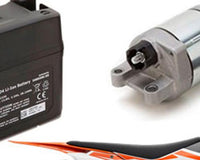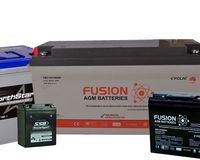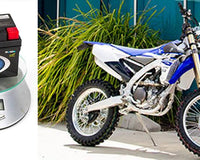Table of contents
- SSB Lithium Ion Batteries introduction
- More about SSB Lithium Batteries Chargers
- Common Faults with the SSB Lithium Batteries
- What To Do When The Ssb Lithium Batteries Is Not Working?
- Other Commonly Encounter SSB Lithium Batteries Faults
SSB Lithium Ion Batteries
The SSB lithium batteries have two different series. The LFP range, which is their lightweight entry-level series with a one year warranty. The other one is their LH series, which is a high-performance range and comes with a 2-year warranty. They always have higher CCA ratings ( cold cranking amps ).
When asked about choosing between the LFP series or the LH series, I tend to steer people towards the LH series, particularly when being used dirt bikes. The KTM 300's 2T benefit a lot from using the LH5L-BS 220 cranking amp battery. The LH5L-BS gets the bike started off the button from cold first time. It also saves the notoriously poor starter motors which often fail after about 50 to 70 hours. They start throwing Bendix and the brushes wear our prematurely and all those sorts of problems. I found with the three KTM 300's that I've owned and also giving several of these batteries to my mates this all but solves all those problems and that is why people rave about them. This effect is similar across the board with all bikes by them getting better starting power and reliability. They're all-around a much better battery for most situations.
Is it okay to put SSB Lithium Batteries on a trickle charger?
This is one of the main questions I get when it comes to charging. You do not need to put it on a trickle charger - particularly on dirt bikes. The main reason for this is that the technology of lithium batteries and the way they respond to charging, in the last 10% of the charging cycle is when it produces the most amount of heat. That is where it puts the most stress on the battery.
When you leave the battery on a constant trickle charge, it will keep on trickle charging it unnecessarily. Keeping it topped up to that 100% range where it doesn't need to be. So, that is where the longevity of the battery can be compromised. It's not going to ruin the battery within the warranty period. It won't even significantly reduce life. But, instead of getting four to five years out of a high-performance series, you might get three to four. But, it's completely unnecessary, and you will get zero benefit from trickle charging it.
Particularly, while the battery's new, once it gets to that three to four-year-old mark and you notice the decline myself being a racer, I would just replace it. Given that it's one hundred and fifty to one hundred and eighty dollar investment that gets you off the line and the to first corner first every time It's one of the cheapest modifications and maintenance that you can do to your bike.
Still, if you insist that you must charge it, you need to be careful with the kind of charger you use. It is even more important than actually how often you charge it if at all. You need to make sure that it is a basic style charger with no pulse mode or auto rejuvenation
More about SSB Lithium Batteries Chargers
The Victron VECIP65-12/5 is quite good for pretty much all the motorbike batteries. It has lithium mode, and it also and AGM mode so you can charge all different kinds of batteries with it. Another thing to note is if you have a smart charger. Often, they are five to seven-stage charges. Most of these are not suitable. You need to make sure that your charger does not have an auto rejuvenation mode or pulse mode. This is where a lot of damage can occur. It will not only lead to damage to the battery, but it will also void your warranty.
Also, you need to make sure that the amp rating of the charger does not exceed the specifications of that particular battery. Now, if the particular battery has a maximum charge rate of 5 amps, it is best to use a 4amp charger or lower. Even then, I do not recommend charging it, unless you really have too. For dirt bikes, a lot of them have a kick starts so simply fold out the kicker and kick start it and charge it using the bike. You could also jump-start it if you need too but other than that, I wouldn't touch it.
The best way to care for your High-Performance Lithium battery is to simply install it and forget about it!
Common Faults with the SSB Lithium Batteries
Most of the time, people will call and say:
"I've got this battery, I've tested the voltage, and it's sitting around 1 to 2 volts,"
They usually put it on the charger, but it won't charge. The reason why in 95% of cases is that they'll be connecting it to a smart charger. Now, usually, when it's from 1 to 2, volts, it is not a fault with the battery. There is a safety feature to prevent over-discharge of the battery at about 10 volts. This is when the low voltage cut off kicks in from the internal BMS (battery management system). This is to protect the battery from over-discharging.
Now, we run into the issue with these smart chargers. It's when people connect them and the smart chargers normally need a voltage 3 - 4 volts to recognise that a battery is connected. So, they basically never start charging. Often, people have put them on charge and they'll leave it overnight come out and it has not charged at all which leads them to think that the battery is faulty or has failed prematurely.
What to do when the SSB Lithium Batteries is not working?
- There are a couple of things you can do. You can put it on a manual charger. Within around about 30 seconds to a minute, you'll see that voltage to comes up from 1 or 2 volts. It will come straight up to about 11 or 12 volts. Then, you can go ahead with normal operating procedures for charging.
- The other option is you can jump-start your bike, then leave it to charge in your bike, or you can roll start it but that is not possible with dirt bikes a lot of the time when it is muddy, slippery ground. Another very good investment. that I use is a projector Lithium jump starter that is 1200CCA, which is really good for starting my Jeep Grand Cherokee Diesel. So I highly recommend putting one of them in the back of your car and you never need them until you do. They're an absolute godsend so also look at getting one of them if you don't already have one. Once you then get that charge into the battery, you'll have a trouble-free operation. No damage has occurred to the battery because of the voltage cutoff. So, continue using it trouble-free for hopefully for another three, four or even five plus years to come.
- Another thing maybe a faulty battery can be the reason for it. The charge voltage can't exceed 15 volts but the ideal range is between 14 and 15 volts. Make sure it does not exceeds charging it above the 15-volt mark or even too high ampere input right the battery.
- The best-case scenario that happens most of the time is that the battery basically has an internal fault and a cell fails dropping the voltage down to somewhere around the 9 to 11 volt mark. At that stage the battery is unrecoverable. If it is the result of overcharging or incorrect use, the warranty is void and you'll need to get a new battery.
- The other one is that there are just times where a cell fails by itself and if that happens that's a warranty issue, and it's replaceable under warranty if still within the warranty period.
SSB Lithium Batteries Faults
If you exceeded that 15-volt mark and it doesn't drop a cell before the internal BMS is overcome by the voltage and if it gets on the higher end of 15 volts, sometimes 18 to 20 volts. Often this is a result of a faulty regulator and I've seen that happen in CRF250's and 450s from time to time. Basically, one of the outcomes will be is that the battery will get very hot. It will melt, and there will not be an "explosion" but there will be a release of gases that will go for anywhere from 2 to 3 minutes and it is quite a spectacular site all be it not when it is happening to your bike and in an uncontrolled environment.
The case will get very hot, there will be no fire or flames. Basically, it will be safe, but it will look pretty spectacular as its white non-toxic gases are released so it looks like smoke. At that time there is basically nothing you can do that will stop it, you just need to sit back, let it do its thing, and then pick up your melted battery cradle and the melted battery.
Most of the time you'll notice that not only the casing of the battery will melt but some of that battery cradle will melt as well, so you'd be up for a new battery cradle. I've never seen this to happen in any of the KTM's but I have seen it happen in a CRF, and I have seen it happen in a TM as well. It actually happened three times in one TM. A gentleman told me that his regulator was absolutely fine. There were no issues with it at all. But, given that it happened to three batteries, I looked at that as there is no way that it's a coincidence. I never heard from that gentleman again. But, I could almost guarantee you that it was a faulty regulator or user error. However, user error was eliminated while I was troubleshooting the issue with him.
That's the only time I haven't been able to diagnose a problem. He never actually came back to me, but I would be willing to bet my house the regulator was the culprit. You just don't get a coincidence where three go at once, and I've never seen one that just went for no reason. We don't even get 3 warranty batteries back a year let alone from the one user.
The other thing to look out for is a lot of people will see that they can get 400 cranking amps out of a battery, and that its enough to start my V-twin Harley. They will put that in their V-twin Harley, and it will start and work well. Within two weeks, they will bring me their battery that is no longer working as soon as I ask what kind of bike they put it in and I say that their number one, two and three mistake was that they did not use the compatible part number for their bike.
They specifically design the batteries to deal with the current output from the stator or alternator. So if the original code on your battery is a YTX4L or 5L or something like that, you should replace it with a battery. If it were a 5L, you would replace it with an LH5L; there is also a YTX7-BS. In that case, I can recommend you to use a 5L in that but the 7L as well. But there will not be any damage that occurs if you use a 5L in a dirt bike that normally takes a 7L and they actually have similar specs but the 5L is a little bit lighter. So I would actually recommend it in that case.
For instance, if you are looking at a battery that normally goes in an R1 or GXR or something like that. Then you put it in a V-twin Harley, you're definitely asking for trouble. Make sure that you don't make the mistake of putting too small of a battery in your bike. You've definitely got to check the output of the stator and match it to the specs of the battery. Often with Harley's where they do customisations; they've only got a certain amount of space to put it in. So, in that case, you need to be very careful, and you need to check the output of the stator, a solution that can be used for putting undersized batteries in bikes is to have regulator just for the battery to control that. People may also want to use them as Automotive Batteries, you will need to spec to your Auto-Elec about doing this successfully.
You can do a modification to limit the current and limit the voltage that comes in from the bike. But, that is outside of the scope of what we offer and what we can supply. You would need to talk about this with your bike mechanic and proceed with caution.
As far as Lithium Motorcycle batteries go SSB Lithium Batteries are the market leader, and yes I have used personally used these myself with great success. They are absolutely an amazing product when used for what they are designed to do.










